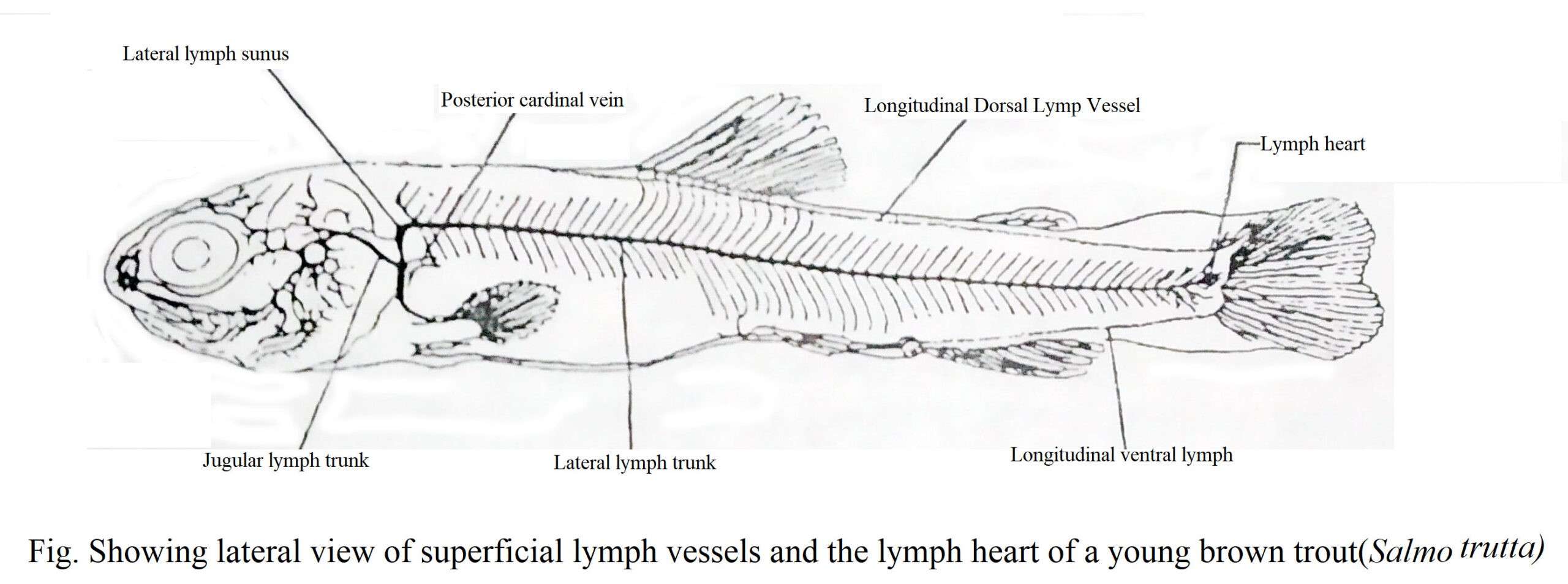Teleost is a diverse group of ray-finned fishes which belongs to largest infraclass Teleostei under the class Actinopterygii. The group teleost includes 40 orders and 448 families with over 26000 species. They are the most advanced fish among the bony fishes. The world`s important sport and commercial fishes include this group. The length of the teleost ranges from 6.2 mm to 7.6 m or more. In this case, the giant oarfish(Regalecus glesne) grows up to 7.6 meter in length or more with over 1 tons in weight while the male angelfish (Photocorynus spiniceps) grows up to just 6.2 mm in length.
Lymphatic System of Teleost Fishes
Like other vertebrates, fish collect lymph from all parts of the body through a system consisting of paired and unpaired ducts and sinuses, which ultimately return into the main bloodstream. The upper vertebrates have lymph nodes but are absent in fish.
The lymphatic system of lamprey and hagfish (Cyclostomata) is characterized by more numerous and more diffuse connection with the blood circulatory system than exists in other groups of fishes. Because of this close connection, the blood vessels are called the hemolymph system. The lamprey and hagfish have a large abdominal lymph sinus that enters into the lymphatic ducts of the kidneys and gonads.
There are several valve openings in the sinuses of the cardinal vein. The valves allow lymph flow to enter the veins and prevent a back flow of venous blood into lymph sinuses. The head region of lamprey contains superficial and deep lymph sinuses where the valves of a lymphatic peribranchial sinus are connected to the jugular veins.
In the Elasmobranch, the lymphatic system contains much lymph vessels than the sinuses, but the cyclostomata and osteichthyes do not contain contractile lymph ‘heart’.
The sub-vertebral lymph trunk is situated in the hemal canal of the tail vertebrae which collects lymph fluids from the tail region. It then merge into the abdominal lymph duct which form a network of blood vessels with the lymphatic system.
The lymph-collecting vessels from the segmental musculature and intestinal organs flows into the sub-intestinal lymph trunk which in turn open into the cardinal sinuses near the site of origin of the subclavian artery from the aorta. Subvertebral lymph trunks extend into the head and where they collect lymph from the cranial and branchial regions.
The lymphatic system of fish is thought to be more likely to originate from the veins than the arterial part of the blood circulatory system. In Elasmobranchii, Chondrostei and Holostei, the complexity of its growth, development and number is gradually increased.
In teleostei, the arrangement of the lymphatic vessels is better than that of the terrestrial vertebrate, and the branches of the subcutaneous lymphatic ducts are more extensive. The lymph from the head region collects in the branched sinuses and flows into the sub-scapular sinuses of the pectoral region, where it is unite by fluid from the three main lymphatic ducts of the body-the dorsal, lateral, and vertebral subcutaneous lymph trunks.
Neural, arterial, and hemal sub-musculature lymph trunk collect the lymph fluids from body musculature. On the other hand, the lymphatic ducts of the visceral organs divide and form superficial and a deep systems. The deep visceral lymphatic duct absorbs fat from the intestinal mucosa and carries it to the coeliaco-mesenteric lymph trunk where the remaining lymphatic ducts are probably connected to the subvertebral trunk.
The lymph enters into the paired para-renal lymphatic duct from the bladder, gallbladder, abdominal part of the kidney, and other organs of the body cavities and subsequently ends in the pericardial sinus.
In Actinopterygii, the lymph reaches the main bloodstream through the anterior (cephalic) lymph sinus, which opens into the cardinal vein, and such conditions can be observed in conger eel(Comger) and freshwater eel (Anguilla).
The opening of the anterior lymph sinus connecting the blood and lymphatic system, also exists in the jugular vein, as seen in some fish Morays (Muraena), and in Pike (Esox), or in the posterior cardinal veins as in some members of the family Salmonidae (Salmo).
In conger eel (Conger) and freshwater eel (Anguilla), a false lymph heart is located in the cephalic sinus and keeps the lymph flow intact through the movement of the gills but a true lymph heart with valves and cardiac muscle contractile fibers occurs in the caudal region of both Anguilla and Salmo.
A small blister-like flattened structure appears in the hypural on the ventral of the last vertebra of the true lymph heart, which is covered by muscles and skin. They make contact with the lymphatic ducts and caudal veins of the body and are double-chambered and valved; they are thought to further venous flow.
You might also read: Arterial and Venous System of Lamprey(Petromyzon)

